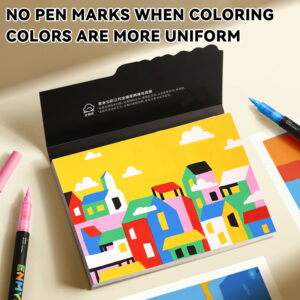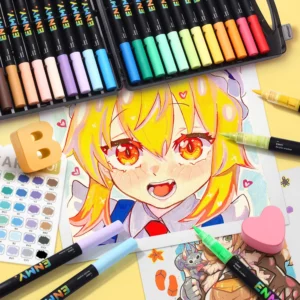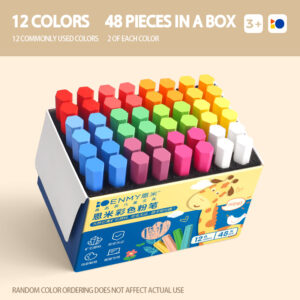The development of modern children’s stationery is a transformation driven by the advancement of science and technology, the innovation of educational concepts, and changes in market demand. From the mid-to-late 20th century to the present, in just a few decades, children’s stationery has evolved from simple writing tools to comprehensive products integrating functionality, safety, fun, and educational value, profoundly influencing children’s learning methods and growth experiences.
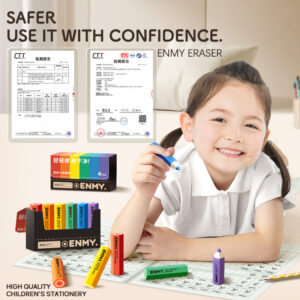
The 1960s-1970s marked the beginning of the “safety awakening” of modern children’s stationery. Prior to this, some stationery had obvious safety hazards, such as pigments with excessive lead content and small easily detachable parts. With the improvement of awareness of children’s safety, various countries successively introduced relevant standards, forcing the stationery industry to upgrade. The United States established the Consumer Product Safety Commission (CPSC) in 1970, which clearly stipulated that pen caps must have ventilation holes (to prevent suffocation from accidental swallowing) and that small parts must have a diameter of no less than 3 centimeters; the European Union launched the EN71 standard, strictly restricting heavy metals and harmful chemicals in stationery. During this period, manufacturers began to use non-toxic pigments to make watercolor pens, produce rulers with softened plastic, and design scissors with rounded blades. “Safety” became the core competitiveness of children’s stationery. At the same time, the popularization of plastic materials made stationery shapes more diverse, and cartoon images began to appear on pencil cases and erasers, such as Disney classic characters printed on stationery surfaces, making learning tools more attractive.
The 1980s-1990s saw functional innovation become the mainstream. During this period, the education sector emphasized “education through entertainment”, and stationery began to carry more learning-aid functions. The birth of washable watercolor pens solved parents’ cleaning problems. After children doodled on clothes and furniture, they could be easily erased with clean water; mechanical pencils got rid of the trouble of sharpening, and the push-type core design made writing smoother. With lead cores of different hardness (HB, 2B, etc.), they met the diverse needs from writing to painting. In addition, “modular” stationery emerged, such as pencil cases with calculators and detachable ruler sets, integrating multiple functions for easy carrying and use. At this stage, stationery manufacturers began to segment the market and design products for different age groups: thick-barreled pencils (suitable for small hands to hold) and large-sized crayons for young children; fountain pens with pen holders for primary school students to help correct writing postures, reflecting attention to the laws of children’s growth.
In the early 21st century, the digital wave injected new vitality into children’s stationery. Electronic learning tools began to integrate with traditional stationery, and the point-reading pen became a representative product. It identified invisible codes on books through a built-in chip, converting text into voice, allowing children to learn English and recognize animals and plants through “point-reading”, realizing “audio reading”. At the same time, electronic writing tablets gradually became popular. They adopted pressure-sensitive technology, allowing children to write with a special pen and then clear it with one click, which could be reused without dust, becoming a new choice for family graffiti and classroom exercises. However, digitalization in this period did not completely replace traditional stationery, but instead formed a complement: pencils and exercise books remained basic writing tools, while electronic devices were responsible for expanding learning scenarios, and the “online + offline” learning model initially took shape.
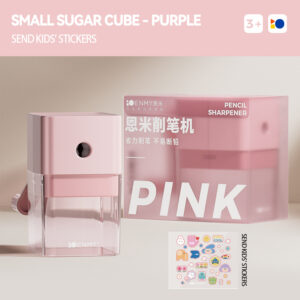
In the past decade, children’s stationery has entered a stage where “personalization and environmental protection” go hand in hand. Consumption upgrading has made parents pay more attention to the “sense of exclusivity” of stationery, and customized services have emerged – children’s names can be engraved on pencils, cartoon patterns embroidered on schoolbags, and even children can participate in designing the appearance of stationery. This “unique” experience makes stationery a carrier for children to express their personalities. The deepening of environmental protection concepts has promoted the innovation of stationery materials: degradable erasers made of corn starch can decompose naturally when buried in the soil after use; notebooks made of recycled paper with environmental protection slogans printed on the cover; some brands have launched “plantable stationery” with flower seeds hidden in the pen barrel, which can germinate when planted after use, integrating environmental education into daily use.
In addition, the in-depth excavation of “educational attributes” is a significant trend in recent years. Stationery is no longer just a “tool” but also a “teaching aid”: arithmetic exercise books are printed with interesting math games, allowing children to pass levels while doing exercises; painting sets are accompanied by step-by-step teaching manuals, guiding children to learn from simple lines; literacy cards are made into puzzle forms, allowing children to memorize Chinese characters while splicing. This “learning through play” design is in line with the concept of “quality cultivation” in modern education, making stationery a “partner” for children to explore knowledge.
Looking back at the development of modern children’s stationery, every progress revolves around the core of “child-centeredness”: from ensuring safety to improving functions, from integrating fun to carrying education, from adapting to traditional learning to embracing the digital age. In the future, with the development of artificial intelligence and new material technologies, children’s stationery may have more cross-border integration forms, but no matter how it evolves, the original intention of “helping children grow up healthily” will always be the unchanging direction of its development.





